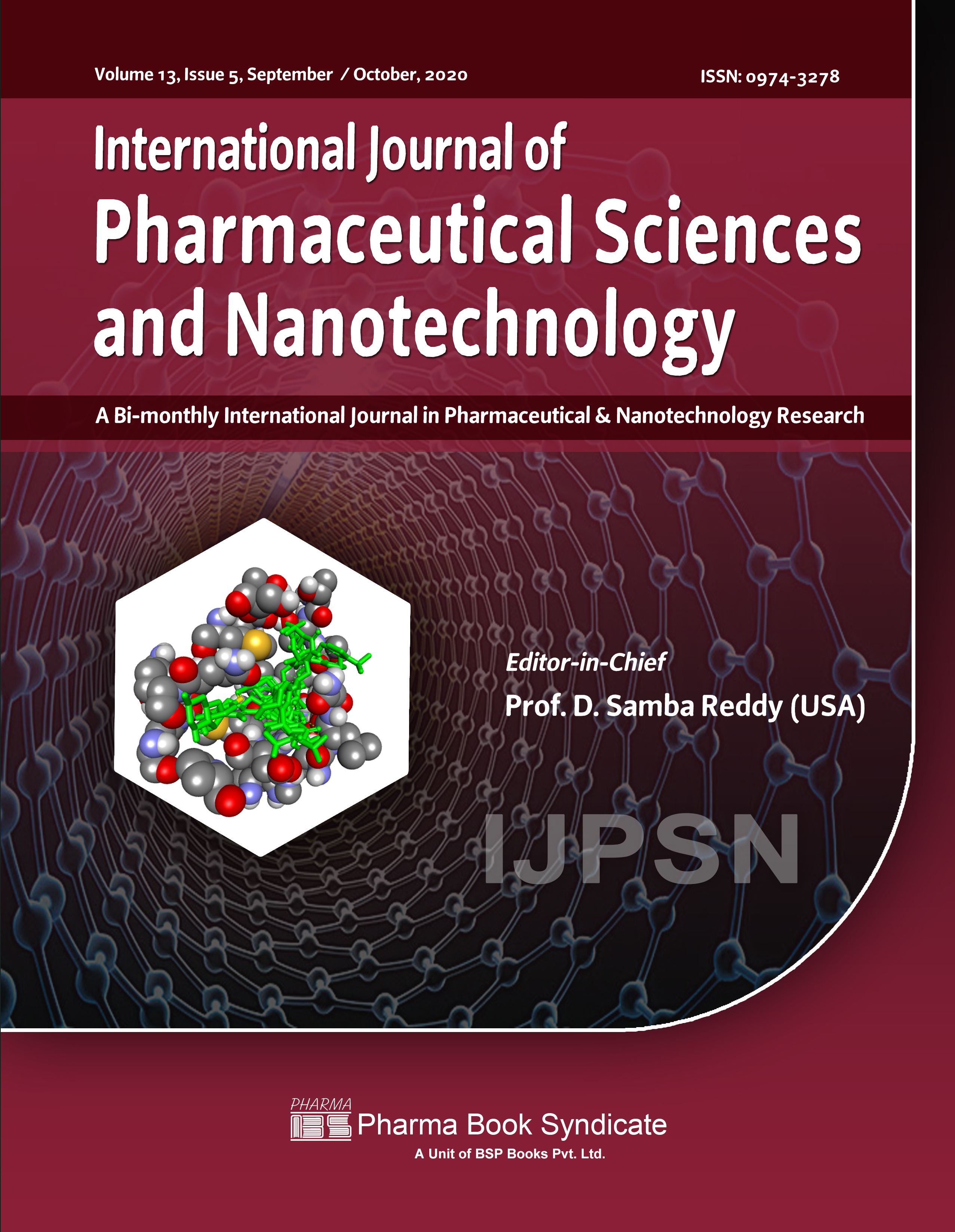Formulation and Development of Pantothenic Acid Grafted Solid Lipid Nanoparticle for Site Specific Delivery of Chloroquine
DOI:
https://doi.org/10.37285/ijpsn.2020.13.5.11Abstract
Chloroquine phosphate (CQP) is one of the widely used drug in treatment of malaria. The use of CQP is declining due to development of resistance and plethora of side effects. SLNs were prepared by cold homogenization technique after applying the 32 level factorial design and grafted with ligand pantothenic acid for site specificity. The prepared formulations were evaluated for different physicochemical properties and were found to be spherical in shape with a size ranging between 92.25 ± 0.54 nm with polydispersity index of 1.15 ± 0.12, which is an ideal size for intravenous administration. The zeta potential of the SLNs was found to be +7.78 ± 0.12 mV. The entrapment efficiency was found to be greater than 94.51 ± 1.19% w/w. The in-vitro drug release studies showed a sustained drug release from the lipid matrix which was below 59.8% within 72 hrs. Furthermore, in-vitro erythrocyte toxicity test was performed on SLNs and pure drug. The study revealed that the encapsulated CQP showed lesser haemolysis (24.5 %) compared to pure drug (62.41± 0.16 %). These findings suggests that the encapsulated drug showed lesser haemolytic activity and thus can reduce the side effects associated with drug administration by direct intravenous route.
Downloads
Metrics
Keywords:
Chloroquine phosphate (CQP), Solid Lipid Nanoparticles (SLNs), Pantothenic Acid (PA), P. falciparum, In-vitro erythrocyte toxicity testDownloads
Published
How to Cite
Issue
Section
References
Bloland PB (2001), World Health Organization. Drug resistance in malaria. 1-24
Bolton, S., Bon, C. (2004). Pharmaceutical Statistics: Practical and Clinical Applications 4th Ed. Marcel Dekker, New York.
Costa P, Lobo JM (2001). Modeling and comparison of dissolution profiles. European Journal of Pharmaceutical Sciences 13(2): 123-33.
Date AA, Joshi MD, Patravale VB (2007). Parasitic diseases: liposomes and polymeric nanoparticles versus lipid nano-particles. Advanced Drug Delivery Reviews 10; 59(6): 505-521.
Dierling AM, Cui Z (2005). Targeting primaquine into liver using chylomicron emulsions for potential vivax malaria therapy. International Journal of Pharmaceutics 303(1-2):143-152.
Farooq U, Mahajan RC (2004). Drug resistance in malaria. Journal of Vector borne Diseases 41(3/4): 45.
Greenwood B, Mutabingwa T (2002). Malaria in 2002. Nature 7; 415(6872): 670.
Jain S, Mistry MA, Swarnakar NK (2011). Enhanced dermal delivery of acyclovir using solid lipid nanoparticles. Drug Delivery and Translational Research 1(5): 395.
Joshi M, Pathak S, Sharma S, Patravale V (2008). Design and in vivo pharmacodynamic evaluation of nanostructured lipid carriers for parenteral delivery of artemether: Nanoject. International Journal of Pharmaceutics 364(1): 119-126.
Jumaa M, Kleinebudde P, Müller BW (1999). Physicochemical properties and hemolytic effect of different lipid emulsion formulations using a mixture of emulsifiers. Pharmaceutica Acta Helvetiae 73(6): 293-301.
Khajavinia A, Varshosaz J, Dehkordi AJ (2012). Targeting etoposide to acute myelogenous leukaemia cells using nanostructured lipid carriers coated with transferrin. Nanotechnology 23(40): 405101.
Kirk K, Saliba KJ (2007) Targeting nutrient uptake mechanisms in Plasmodium. Current Drug Targets 8(1): 75-88.
Korsmeyer RW, Gurny R, Doelker E, Buri P, and Peppas NA (1983). Mechanisms of solute release from porous hydrophilic polymers. International Journal of Pharmaceutics 15(1): 25-35.
Owais M, Varshney GC, Choudhury A, Chandra S, and Gupta CM (1995). Chloroquine encapsulated in malaria-infected erythrocyte-specific antibody-bearing liposomes effectively controls chloroquine-resistant Plasmodium berghei infections in mice. Antimicrobial Agents and Chemotherapy 1; 39(1): 180-184.
Saliba KJ, Ferru I, and Kirk K (2005). Provitamin B5 (pantothenol) inhibits growth of the intraerythrocytic malaria parasite. Antimicrobial Agents and Chemotherapy 49(2): 632-637.
Santos-Magalhães NS, and Mosqueira VC (2010). Nanotechnology applied to the treatment of malaria. Advanced Drug Delivery Reviews 18; 62(4-5): 560-575.
Tracy JW (2001). Drugs used in the chemotherapy of protozoal infections. In Goodman and Gilman's the pharmacological basis of therapeutics (Hardman JG, Limbird LE Gilman AG), McGraw-Hill International Editions Series, 965-985.
Üner M and Yener G (2007). Importance of solid lipid nanoparticles (SLN) in various administration routes and future perspectives. International Journal of Nanomedicine 2(3): 289.
Vyas SP (2009). Theory and practice in novel drug delivery system. CBS Publishers & Distributors, India.
Vyas SP and Khar RK (2002). Targeted and controlled drug delivery novel carrier systems. 2nd Ed. CBS Publishers & Distributors, India.
Weyhers H, Ehlers S, Hahn H, Souto EB, and Müller RH (2006). Solid lipid nanoparticles (SLN)–effects of lipid composition on in vitro degradation and in vivo toxicity. Die Pharmazie-An International Journal of Pharmaceutical Sciences 61(6): 539-544.
Wissing SA, Kayser O, and Müller RH (2004). Solid lipid nanoparticles for parenteral drug delivery. Advanced Drug Delivery Reviews 56(9): 1257-1272.
Yang SC, Lu LF, Cai Y, Zhu JB, Liang BW, and Yang CZ (1999). Body distribution in mice of intravenously injected camptothecin solid lipid nanoparticles and targeting effect on brain. Journal of Controlled Release 59(3): 299-307.
Zhang L, Pornpattananangkul D, Hu CM, and Huang CM (2010). Development of nanoparticles for antimicrobial drug delivery. Current Medicinal Chemistry. 1; 17(6): 585-594.






